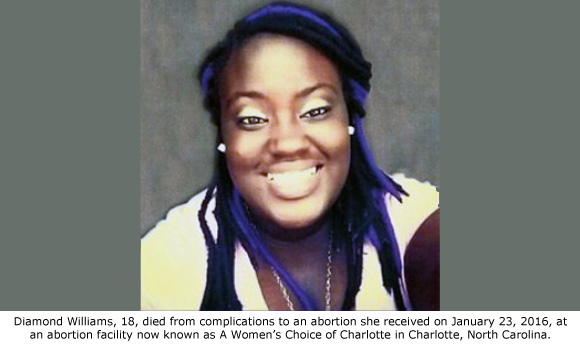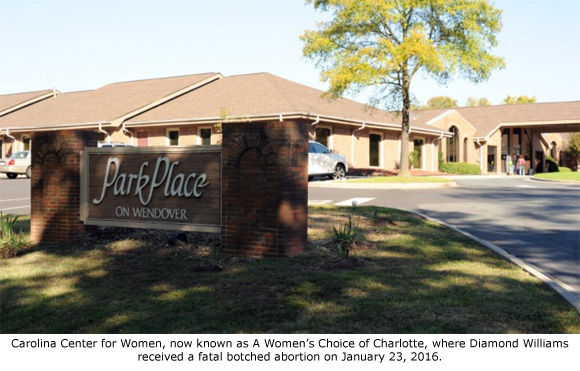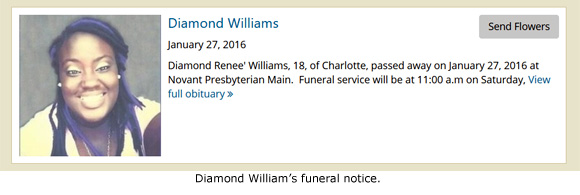By Cheryl Sullenger
Charlotte, NC (July 12, 2018) – Even though Diamond Renee Williams died in 2016, it is still extremely emotional for her mother, Shakira, to talk about it.
It was January 23 of that year, one day after supporters of abortion around the nation celebrated 43 years of Roe v. Wade and so-called “safe and legal” abortion on demand.
But it’s doubtful that eighteen-year old Diamond Williams had the politics of abortion on her mind as she and her mom reported to the Carolina Center for Women, an abortion facility on Wendover Road in Charlotte, North Carolina, for a scheduled six-week surgical abortion.
Diamond, an African-American, was a high-risk patient, but that did not seem to matter to the outpatient abortion facility staff. At five feet, six inches in height, she weighted approximately 300 pounds and suffered from diabetes mellitus, a condition that affects the metabolism of sugars and carbohydrates in food. Her risk of complications was high enough that a hospital setting would have been a much safer environment for any surgery.
Because of her medical issues, the clinic’s staff should have turned her away. Accepting her as a patient proved to be a fatal mistake.
Diamond was one of the first to arrive that morning for the abortion. Her mother sat patiently in the waiting room at first, but after several hours, she began to worry. When the staff started to turn off the lights in the office at the end of the day, Shakira had to bang on the glass in the reception area to get someone’s attention. She needed to know what was happening with her daughter.
Eventually, Diamond was escorted out a side door and discharged to her mother.
Shakira understood that Diamond would experience some initial pain, but after a restless night, Diamond called the clinic’s after-hours operator for help. The operator told her that pain was normal, but to watch for excessive bleeding and fever. Since she had neither symptom, Diamond thought everything would be okay.
By Monday, Diamond was still in a lot of pain and Shakira suggested that she call the clinic again to see about returning for a follow-up visit. Diamond was told that a nurse from the clinic would be following up with her later in the day, but she never received a call-back.
Tuesday evening, Diamond began to feel a little bit better. As a precaution, Shakira planned to take Diamond to see their primary care physician the next morning.
But less than five minutes after Diamond went to her room to prepare for bed, Shakira heard another of her daughters scream.
“I ran to find Diamond lying face down unable to speak and foaming at the mouth,” Shakira told Operation Rescue. “We called 911 and the operator said from what I was explaining, my daughter may have just suffered a seizure.”
As Shakira heard the sirens approaching in the distance, painful memories of another tragic night flooded her mind. Diamond had been born with a twin brother who died at just three-months old. The sound of sirens had filled that tragic night as well. This time, they triggered a kind of post-traumatic stress in Shakira — and now her worst fears were coming true. Tragedy was again striking down one of her children.
A fire unit arrived and found an hysterical family, but apparently they perceived that as aggression and summoned a police unit. The other children and the family dog were shut into a bedroom, presumably for the responder’s safety.
It is unclear what steps the emergency responders actually took to save Diamond, but for Shakira, it seemed like they weren’t doing much, and she wondered why they weren’t working harder to help her daughter.
A note in Diamond’s autopsy report indicated that Diamond had no pulse when paramedics arrived, but Shakira insists that Diamond had revived after her apparent seizure.
Shakira told Operation Rescue that paramedics tried but were unable to get Diamond to stand on her own. After about 30 minutes, they rolled her onto a body bag and dragged her out the patio door. It was only then that she was placed on a stretcher and transported to Novant Health Presbyterian Medical Center in Charlotte.
Shakira wasn’t allowed to ride with her daughter in the ambulance but was grateful that a police officer on the scene showed compassion and drove her to the hospital. There, she was placed alone in a room to await word from the doctors. Shakira was relieved when a hospital chaplain arrived and prayed with her until a doctor finally came to tell her that her daughter had a pulse and would be transferred to the Intensive Care Unit.
Shakira was allowed to see Diamond briefly but noticed that her daughter was “bleeding from everywhere.” Her blood pressure never stabilized and Diamond was pronounced dead on January 27, 2016 – four days after her “safe and legal” abortion.
Instead of allowing the county coroner to conduct the autopsy, the hospital performed the autopsy on the scene. Even the funeral home had a difficult time finding Diamond’s body since the coroner never received it.
Because Diamond was 18 at the time of her death, Shakira was not allowed to obtain copies of her daughter’s medical records. She hired an attorney, but it took over a year for her to receive the hospital’s autopsy report – and an incomplete version at that. Page numbers show that only pages 59-62 of a larger document were released.
Strangely, no cause or manner of death is noted in the truncated autopsy report. Preliminarily, the diagnosis was an amniotic fluid embolism and Disseminated Intravascular Coagulation (DIC), a blood clotting condition that causes hemorrhaging of internal organs as the result of some internal trauma or infection.
However, it was later determined that the embolism was insufficient to cause death. Instead, it was determined that she suffered from acute hemorrhagic bronchopneumonia and other symptoms consistent with DIC.
The autopsy so found “retained products of dissection.” While that finding was largely ignored, Diamond’s incomplete abortion may have been the source of the DIC’s onset.
Shakira’s attorney notified her earlier this year that he could no longer represent her. She later discovered that he had been representing the abortion clinic on another matter, but never told her of the conflict of interest.
Shakira also was never told the name of the person who conducted Diamond’s incomplete abortion. She continues to await additional requested documents, including records from the Carolina Center for Women. Because she lacks that documentation, it has been difficult for Shakira even to file a complaint with the North Carolina Medical Board over her daughter’s botched abortion and failure to follow up.
Complicating the pursuit of records, three months after Diamond’s death the clinic changed its name to “A Women’s Choice of Charlotte.”
Now, over two years after Diamond’s passing, Shakira has finally found the strength to fight to right wrongs done to her daughter. Although the process has been very difficult, she wants people to know what happened to Diamond.
Whether a person is pro-life or pro-choice, no one should think it’s okay for an abortionist to conduct a surgical abortion in an ill-equipped abortion facility on a woman whose risk factors contraindicate outpatient surgery.
No one should think it’s okay for an abortion facility to fail to follow up with a woman suffering complications from an abortion.
And no one should think it’s okay for an abortion clinic attorney fail to disclose a conflict of interest then to delay the release of complete documents to a grieving family member.
“There are still a lot of questions surrounding Diamond William’s death,” said Operation Rescue President Troy Newman. “Her family continues to suffer from her loss to this day, and they deserve answers as to why so much seemed to go wrong starting with the abortion facility and its apparent neglect. Hopefully, answers can be found along with justice, so this traumatized family can finally begin to heal.”






